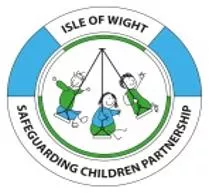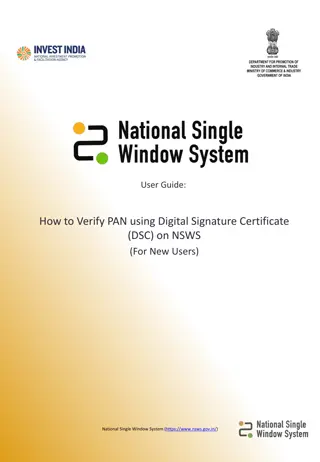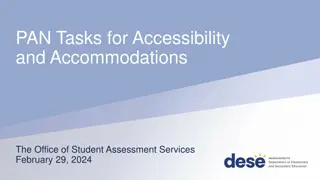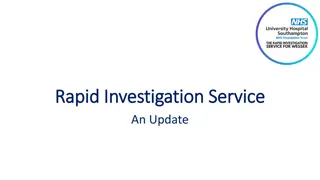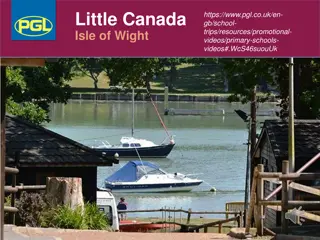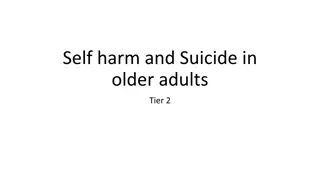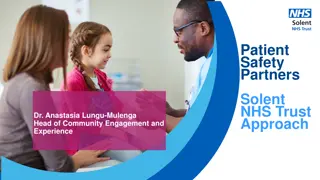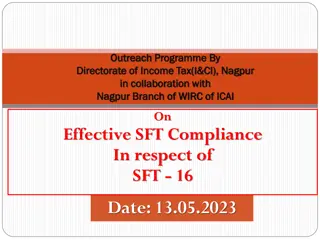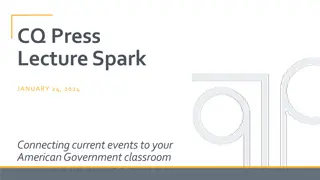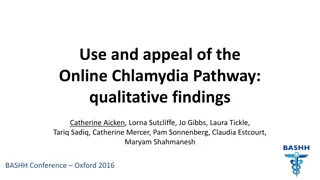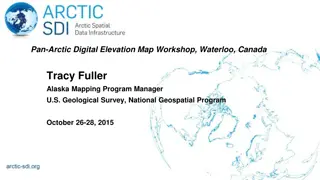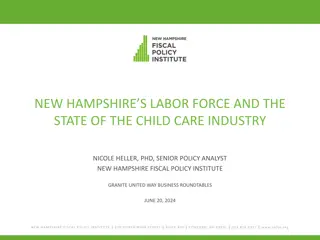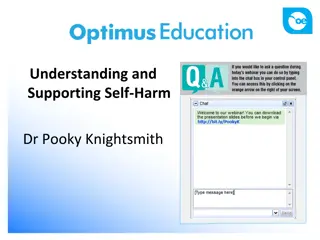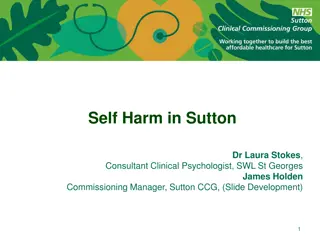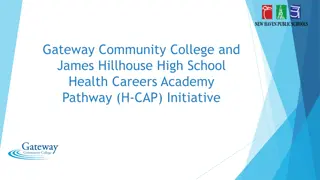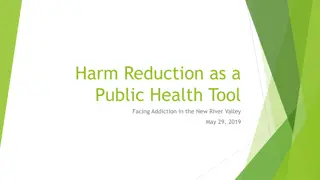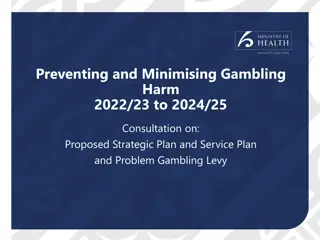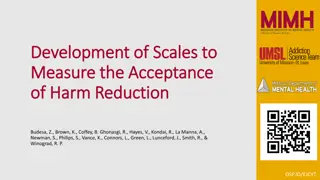Pan-Hampshire & Isle of Wight Self-Harm Pathway for Non-Health Professionals
This pathway provides guidance for children under 18 presenting with self-harm behaviors, including definitions, risk scenarios, suggested responses, and further considerations for urgent medical and psychological support in self-harm cases. It covers various types of self-harm, levels of risk, and appropriate actions for different scenarios, emphasizing the importance of addressing both self-harm and potential harm to others promptly and effectively.
Download Presentation

Please find below an Image/Link to download the presentation.
The content on the website is provided AS IS for your information and personal use only. It may not be sold, licensed, or shared on other websites without obtaining consent from the author. Download presentation by click this link. If you encounter any issues during the download, it is possible that the publisher has removed the file from their server.
E N D
Presentation Transcript
Pan-Hampshire and Isle of Wight Self Harm Pathway for Non Health Professionals This pathway relates to all children under 18 years who present with self-harm behaviour in the community as follows: Self-harm Self-harm describes a wide range of things that people do to themselves in a deliberate and usually hidden way. In the vast majority of cases self-harm remains a secretive behaviour that can go on for a long time without being discovered. Self-harm can involve: Attempted hanging; Overdosing of tablets or medicines; Cutting, often to the arms using razor blades, broken glass or knives; Burning using cigarettes or caustic agents; Punching and Bruising; Inserting or swallowing objects; Head banging; Pulling out hair or eyelashes. Self harm can sometimes be a coping mechanism with the aim of relieving emotional distress. NB. it must be recognised that the emotional distress that leads to self harm can also lead to suicidal thoughts and actions.
Risk Possible scenarios Suggested Response High to Others There is a significant risk posed to others due to disturbed or violent behaviour. Staff may use common law powers to prevent serious harm, and should feel empowered to take reasonable and proportionate action to protect both themselves and the child as necessary. Significant self harm requiring immediate intervention where there is also a risk to others by intervening for example serious self harm with a blade and the child is unwilling to give it up. Ambulance should be called without delay, if active restraint is being used then make this clear during the call, restraint is classed as a medical emergency. Incidents involving weapons. Police* should be considered at an early stage, especially where there are weapons involved. (*See guidance on slide 3) High to Self Significant, potentially life threatening self harm or overdose, where the child is resistant or reluctant to accept help, or has expressed a wish to leave. Staff may use common law powers to prevent serious harm, if any restraint is to be used then this is considered to be a medical emergency due to the risks involved, and so Ambulance to be called without delay. (Ambulance will be able to deal with Resistance or Reluctance, if Violent or Aggressive beyond the ability to manage then consider Police*) * See guidance on slide 3 If the child is in need of a MHA assessment and is in immediate need of care or control and is not in a house / flat / room / garden Police can be requested to consider detaining the child under s136 MHA. Med / High Acutely distressed or disturbed with or without a secondary medical need. Take advice from CAMHS and / or NHS 111. Consider 999 Ambulance, especially for overdose. Consider conveyance to ED. Actively Suicidal or potential overdose. Med / Low Suicidal Ideation During working hours - contact CAMHS single point of access, or if open to CAMHS contact that specific team. OOH consider calling NHS 111 for triage or attending A&E. Self harm that could be significant but not life threatening, requiring treatment beyond basic first aid. Low Minor or cosmetic self harm not requiring treatment beyond minor first aid. Child to see GP or school counselling service. Consider calling the 111 Service if the route for support is not clear.
Further considerations Further considerations The following factors should be used when considering whether a child is in need of urgent medical treatment / psychological support and should be taken to a Hospital Emergency Department: Has declared or is suspected to have overdosed on illegal or prescription drugs Has consumed large volumes of alcohol Has injuries i.e. cuts, broken bones that require medical attention Has declared or is suspected of attempted asphyxiation / hanging Is actively suicidal, i.e. continues to state that they will commit suicide and needs to be prevented from doing so. Consider also completing a Safeguarding referral alongside calling other agencies, if: Noteworthy safeguarding concerns exist There are less specific, but active concerns about Safeguarding, in particular relating to Child Sexual, or Criminal Exploitation * When considering whether to call the Police to respond to an incident of self harm: If the child is presenting a significant, current risk of serious harm to themselves or another then staff can use common law powers to prevent serious harm. If restraint is used then this is considered to be a medical emergency due to the enormous risks involved, and so an Ambulance to be called without delay. Police attendance can be considered, however Police restraint techniques rely on pain compliance, hyper extension of joints, pressure points etc which is highly dangerous and almost always inappropriate for a vulnerable person, especially a child. This level of action will sometimes be necessary, but you must consider if this is likely to increase or reduce the immediate risks. The professional present will remain responsible for the welfare of the child, this responsibility does not get displaced by the presence of a Police officer. If you are considering Police support then think about what Police officers may be required to do. Police have no power in law to stop someone self harming, and techniques to "disarm" someone will often increase risks rather than reduce them. Police will consider attending in order to prevent or deal with offences, protect staff (using s3 Criminal Law Act), consider detention using s136 Mental Health Act if grounds exist, assist staff in utilising the Mental Capacity Act where there is a risk towards staff in effectively actioning this.
Pathway for management of child who is self harming Call ambulance and take immediate preventative action and/or first aid as appropriate. Is there a risk of serious harm to others? Weapons? Criminality? Is the child presenting a severe, current risk of causing serious harm to themselves Yes No N N O No Is urgent medical treatment required and/or is the child acutely distressed? Consider calling Police* See guidance on slide 3 Yes Hospital No O N No Is the child stable, in the context of significant, urgent concerns about self harming, or other mental health issues? Contact CAMHS SPA , or if known to a CAMHS team, contact them N In working hours? Yes Yes No GP or other support services. Consider calling the 111 Service if the route for support is not clear. Is the child stable, without urgent, significant concerns? Yes
Local Contacts Hampshire CAMHS Single Point of Access 0300 304 0050 Isle of Wight CAMHS Single Point of Access: 01983 523602 8.30 -5.00 pm Mon - Thursday 8.30 -4.30 pm Fri Children s Services professional line on 01329 225379 (for safeguarding concerns) and 0300 555 1373 (out of hours) Children s Services professional line on 0300 300 0901 (for safeguarding concerns) Portsmouth CAMHS Single Point of Access: Monday Friday 9am 5pm: 0300 123 6632 Out of hours 02392 894419 Southampton CAMHS Single Point of Access 0300 123 6661 (request CAMHS SPA) Children s Services professional line on 023 8083 3336 (in hours) and 023 8023 3344 (out of hours) (for safeguarding concerns) Children s Services professional line on 023 9268 8793 (in hours) and 0300 555 1373 (out of hours) (for safeguarding concerns)



